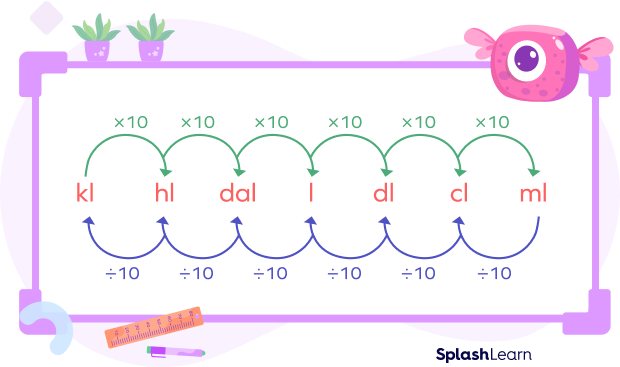You’re baking a delicious cake, and the recipe calls for 250ml of milk, but your measuring cup only measures in kiloliters. How do you figure out how much that is? Or, imagine you’re trying to calculate the volume of water in a swimming pool, and the measurement is given in milliliters – that’s a lot of zeros! These are just a couple of scenarios where understanding the relationship between milliliters (ml) and kiloliters (kl) can be useful.

Image: wetlandsatgb.com
The conversion between ml and kl might seem complicated at first glance, but it’s actually quite straightforward once you understand the metric system. This article will break down the conversion, explaining the relationship between these units and providing tips for easy conversion. We will also delve into the history of the metric system, explore practical applications of these units, and discuss some real-world examples to solidify your understanding.
The Metric System and its Units
To understand the conversion between milliliters and kiloliters, we need to understand the metric system. The metric system is a system of measurement based on the decimal system, meaning it uses powers of ten to relate different units. This makes it a very logical and easy-to-use system.
The metric system is internationally recognized and widely used in science, technology, and everyday life. It is based on meters for length, grams for mass, and liters for volume. Each unit is a power of ten larger or smaller than the base unit.
Understanding Milliliters and Kiloliters
Milliliters (ml) and kiloliters (kl) are both units of volume in the metric system. A milliliter is a very small unit, equal to one thousandth of a liter, while a kiloliter is a much larger unit, equal to one thousand liters. To put it simply, there are 1000 ml in 1 liter, and 1000 liters in 1 kl.
Here’s a breakdown of the relationship:
- 1 ml = 0.001 L (one thousandth of a liter)
- 1 L = 1000 ml (one thousand milliliters)
- 1 kl = 1000 L (one thousand liters)
These basic relationships are crucial for understanding how to convert between ml and kl.
Converting milliliters to kiloliters
To convert ml to kl, we need to divide the volume in milliliters by 1,000,000. This is because there are 1,000,000 ml in one kiloliter (1000 ml per liter x 1000 liters per kl = 1,000,000 ml per kl). Here’s a simple formula for the conversion:

Image: www.math-drills.com
ml ÷ 1,000,000 = kl
For example:
To convert 500,000 ml to kl, we would divide 500,000 by 1,000,000, which gives us 0.5 kl.
Converting kiloliters to milliliters
To convert kl to ml, we need to multiply the volume in kiloliters by 1,000,000. Here’s the formula:
kl x 1,000,000 = ml
For example:
To convert 2 kl to ml, we would multiply 2 by 1,000,000, which gives us 2,000,000 ml.
Tips for easy conversions
Here are a few tips to make converting between milliliters and kiloliters easier:
- Use a calculator: Calculators make converting between units a breeze. Simply input the value in milliliters or kiloliters and perform the appropriate calculation.
- Think in terms of liters: If you’re struggling to grasp the bigger numbers involved with milliliters and kiloliters, try converting to liters first. For example, to convert 250 ml to kl, you could first convert 250 ml to 0.25 liters, and then convert 0.25 liters to 0.00025 kl.
- Memorize the basic relationships: Remember that 1 ml equals 0.001 L and 1 kl equals 1000 L. These relationships are crucial for understanding the conversions.
Understanding how ml and kl are used in real life
Milliliters and kiloliters are widely used in various aspects of our lives. Here are some examples:
- Food and Beverage: Many recipes use milliliters to measure liquids like milk, water, and oil. While large-scale food production often uses kiloliters for liquid ingredients.
- Medicine: Milliliters are used to measure liquid medications, while larger volumes like liters and kiloliters are used for solutions in hospitals and clinics.
- Agriculture: Kiloliters are used for measuring large quantities of water needed for irrigation.
- Fuel: Fuel consumption for cars is often measured in liters and kiloliters.
FAQs:
- Q: Why do we use different units for volume?
- A: Using different units like milliliters and kiloliters allows us to more conveniently express large or small volumes. Imagine if we used only liters to measure everything: a drop of water would be a tiny fraction of a liter, and the amount of water in a swimming pool would require a massive number of liters.
- Q: What is the significance of the metric system?
- A: The metric system simplifies measurement by using a logical, consistent decimal system. Its ease of use and widespread adoption have contributed to its importance in scientific research, global trade, and everyday life.
- Q: Why is it important to understand how to convert between ml and kl?
- A: Understanding how to convert between ml and kl is essential for working with volumes in different contexts. Whether you are cooking, reading a scientific paper, or understanding fuel consumption, being able to convert between these units ensures accuracy and clarity.
Ml To Kl
Conclusion
Understanding the conversion between milliliters and kiloliters is crucial in many aspects of life, from cooking and baking to scientific research and everyday calculations. The metric system provides a logical and consistent framework for measurement, and knowing how to convert between different units ensures accuracy and clarity. Remember, ml and kl are simply different ways of expressing the same quantity, and knowing how to convert between them can be very helpful for various tasks.
Are you curious to learn more about ml and kl, or other metric system conversions? Let us know in the comments below!






